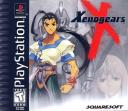Lost Classics: Xenogears (PS1)
by William Talley, filed in Games, Lost Classics on Aug.12, 2007
 This game stands alongside Chrono Trigger as one of Squaresoft/Square Enix’s best role playing games not named Final Fantasy. Although it had a few significant flaws, it’s battle system, music (which was composed by Chrono Trigger soundtrack composer Yasunori Mitsuda), and storyline more than made up for them. The game contained references to Freudian psychology, and it was heavy on religious overtones (in fact Square stated in a press release that it may be hard to bring the game over here due to it’s adaptation of Christian themes, but thankfully it was released, with minimal controversy, and only a few changes being made to the characters and story to boot). Oh, and there was another thing that made it different for it’s time: GIANT ROBOTS!
This game stands alongside Chrono Trigger as one of Squaresoft/Square Enix’s best role playing games not named Final Fantasy. Although it had a few significant flaws, it’s battle system, music (which was composed by Chrono Trigger soundtrack composer Yasunori Mitsuda), and storyline more than made up for them. The game contained references to Freudian psychology, and it was heavy on religious overtones (in fact Square stated in a press release that it may be hard to bring the game over here due to it’s adaptation of Christian themes, but thankfully it was released, with minimal controversy, and only a few changes being made to the characters and story to boot). Oh, and there was another thing that made it different for it’s time: GIANT ROBOTS!
Playing as an amnesiac young man named Fei Fong Wong, the game starts out simple enough. Two people in your adoptive village are about to get married, and you’re tasked with going to the mountains to get a camera from the village doctor. Of course, almost immediately afterwards, the sugar-honey-ice-tea hits the proverbial fan, as giant robots (known in this game as gears) descend upon the village, killing most of it’s population. From then, you escape, and try to make your place in the world. Before long, you’ll be caught up on an adventure of epic proportions, containing psychological and philosophical allusions, biblical references, and even references to movies such as Star Wars and Soylent Green. The story is cinema heavy, and a mix of cel-shaded anime and CGI cutscenes are utilized at various plot points. The narrative hits a bit of a snag on the second disc, as it’s much more narration heavy. Even with that problem, the story manages to stay more compelling and complex than even many of today’s RPGs.
The battle system was also unique as well. Like many other console RPGs of the time, battles in the game are turn-based, although things were carried out a bit differently. At the start of your turn, there are three types of basic attacks, one for weak, another for medium, and a third for hard damage. Each used a specified amount of AP, and you can preform combos by pressing them in certain sequences. Later in the game you can unlock deathblow moves that cause even more damage. Magic can also be used, and instead of certain characters being hardwired into certain roles such as spell caster, healer, or black mage, each character has an equally impressive and useful set of magic spells. The gear combat loosely follows this modes, although you have to keep an eye on your gas level, least your gear loose it’s ability for fight. You can buy parts and upgrades for your gear, and a move known as ‘charging’ can be used to restore your fuel. The battle system, and the awesome music made battles a bit more enjoyable. This was a good thing too, as unfortunately there were lots of random encounters in the game, made even more tedious by the length of many of the dungeons in the game. These few flaws, while very serious, did little to detract from the game itself.
Fans know that Xenogears was planned to be the fifth story in a six-part RPG series. Unfortunately, it’s highly doubtful weather we will see any kind of true follow up, be it a sequel, prequel, or otherwise. It should be noted that while Namco and Monolith Soft’s 3-part PS2 RPG series Xenosaga contains similar events and plot points to Xenogears and is created by Xenogears creator Tetsuya Takahasi, it’s not officially a part of the series cannon. The reason for this is that Square-Enix owns the rights to Xenogears. Even so, Xenogears is one of the finest RPG games of the 32-bit era, and fans of Xenosaga should not miss it.


 PS3
PS3
 Famicom Dojo
Famicom Dojo KEEP PLAYING
KEEP PLAYING KEEP PLAYING: Rewind
KEEP PLAYING: Rewind Powet Toys
Powet Toys Powetcast
Powetcast Hitchhiker's Guide POWETcast
Hitchhiker's Guide POWETcast














